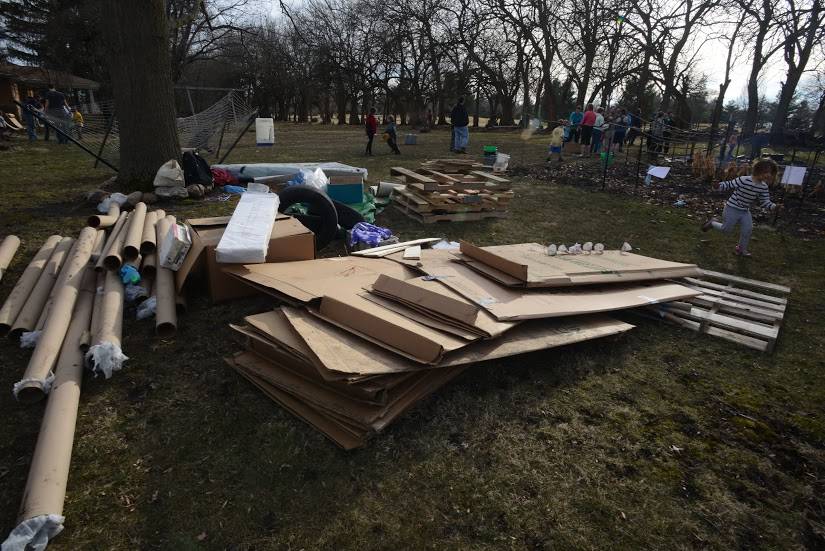This past March, around 100 kids of all ages gathered together to play outdoors. Instead of meeting in a conventional playground, they were given a variety of donated items — cardboard boxes, carpet tubes, straw bales, a gym mat, tires, rope, fabric, and tools — and invited to build their own play world with little to no instruction or intervention from adults. According to Anne LeBauer and Naomi Sukenik, the organizers of this pop-up event, the results were magical.
LeBauer and Sukenik are committed to fostering this kind of play, known as “adventure playgrounds,” in Champaign-Urbana.
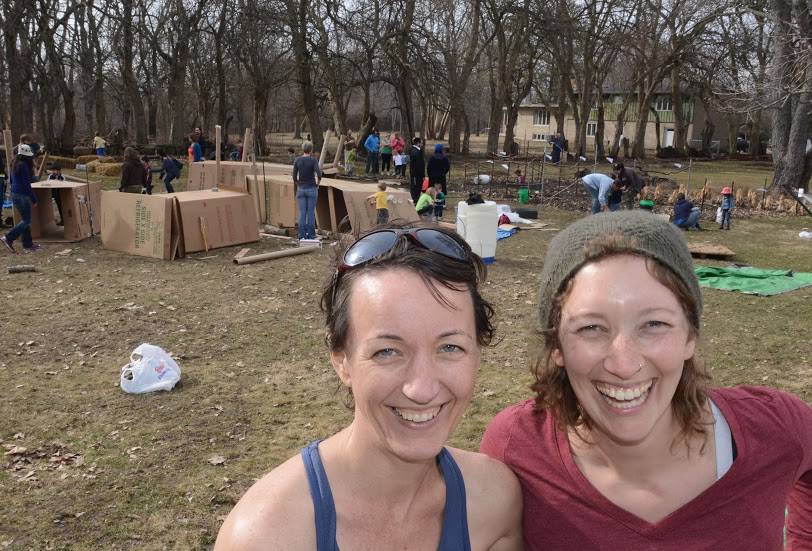
“Adventure playgrounds started in Europe,” said LeBauer, and they have expanded to some cities in the U.S.
“They are staffed by adults, but the approach is hands-off. Adults reflect on what the kids need and provide it, but the kids build the playgrounds on their own with loose parts. That means that the playgrounds are always changing and adapting to suit kids’ needs depending on what stage of development they’re in. It’s amazing what they come up with if you leave them alone.”
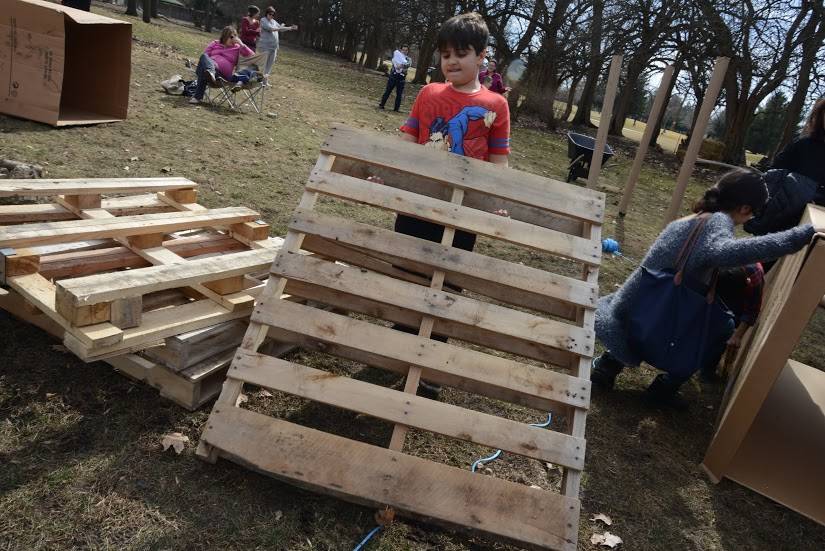
After learning about adventure playgrounds, LeBauer was hooked on the idea that they offer kids the freedom to create their own spaces for play. She said that when she met Sukenik, an outdoors enthusiast and ropes expert, at a holiday party this past December, she immediately thought that those skills would be perfect for adventure playgrounds.
Sukenik was also quickly capitvated by the idea of adventure playgrounds.
“I’ve always had the sense we need to be outdoors more and to get kids to be outdoors more in terms of play,” she said. “When I had children of my own, I realized that all I wanted is for them to play in the mud and use their limbs to figure out how the world works. When I heard about adventure playgrounds, I thought, this is what I want for my kids and what I want in my community.”
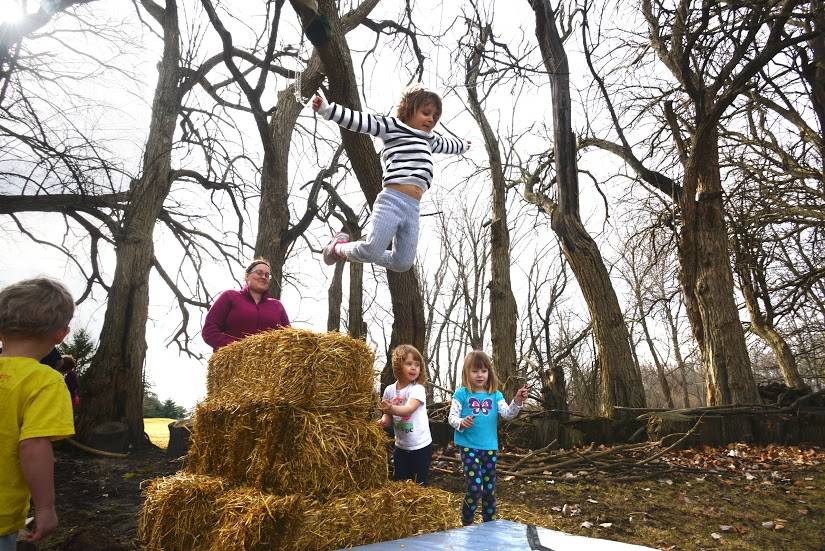
According to LeBauer and Sukenik, adventure playgrounds teach children conflict resolution, interpersonal skills, and how to solve the problems on their own. Adventure playground staff are trained in watching children play and knowing when it is necessary to intervene, and LeBauer and Sukenik are currently training through a play worker course to enhance these skills.
“The theory is that if you let them try things, then they will understand what is dangerous,” said LeBauer. “They’re not going to wait till they’re older to take the risks. If you tell them no, they’re always testing to see what they can do. But if you let them try things, they can figure things out on their own.”
Although this approach might sound scary to some parents, LeBauer emphasized that kids get hurt less on adventure playgrounds than conventional playgrounds. “If you give kids freedom,” she said, “they’re generally more careful. I think people underestimate children and their ability to navigate around things and their ability for self-perseveration. Children are much more civilized than we give them credit for.”
At the adventure playground pop-up in March, kids quickly embraced the idea of autonomous play.
“I have three very distinct memories,” said Sukenik. “First, three girls came in and saw cardboard boxes. Right away, they started building a house. They put in a carpet, and then they made rules about not putting shoes on in the house. All these other kids started joining in. None of them knew each other, but they started collaborating right away. Another thing was the mud pit. Kids started digging a hole and filled it with water. One kid wasn’t strong enough to lift it by himself, so three kids helped him fill a bucket and pour it into the pit. They eventually made what they called a ‘mud jacuzzi.’ I watched as kids took off their shoes, slowly took a step in, and then immersed themselves completely. They were testing their boundaries and seeing if it was okay before they jumped in. That experience helped us learn that kids should bring a towel and change of clothes to these events!”
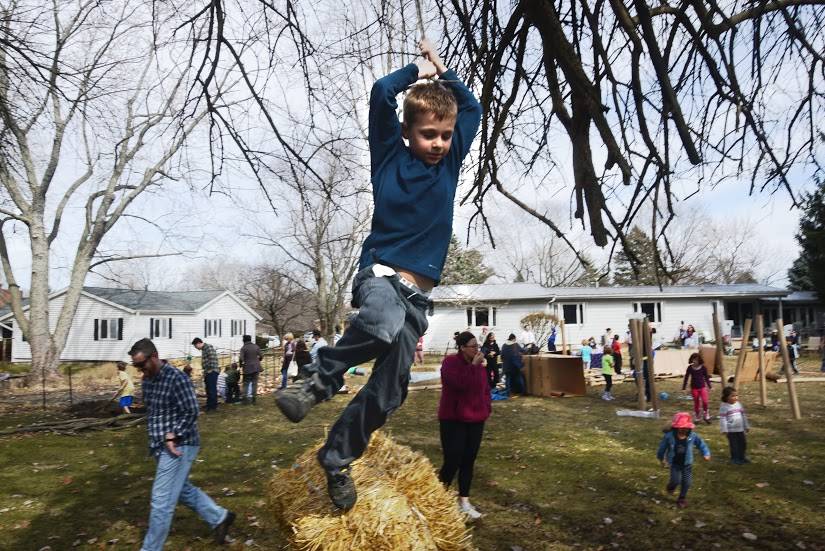
“Another thing,” Sukenik continued, “was that one kid tried to make a structure out of straw bales to jump off. He couldn’t move some of the heavier items, so he got other kids to help him move them. I saw that when kids have an interest, they can learn to motivate others to get involved. I think that’s incredible. I think that’s something that’s missing in today’s playgrounds. I would love to see my kids play like that more.”
For now, adventure playgrounds are continuing as pop-ups, and the next event is this Saturday at 2 p.m. in Champaign. But LeBauer and Sukenik have plans to make adventure playgrounds a more permanent part of Champaign-Urbana. They are currently in discussions with the directors of both park districts to incorporate adventure playground pop-ups into the parks’ summer programming, and they are also reaching out to afterschool coordinators to see if adventure playgrounds can play a role in public schools.
Ultimately, LeBauer and Sukenik would like acquire space for a permanent adventure playground. “We would just need one acre,” said LeBauer, “to make an adventure playground available all the time.”
Photos by Abigail Bobrow








